Communication Skills in Social Work and Human Services Case Study
VerifiedAdded on 2023/06/08
|13
|4024
|170
Case Study
AI Summary
This case study explores communication skills in social work and human services through two detailed cases. The first case examines the cultural factors influencing end-of-life considerations within a Native American family, highlighting the importance of cultural sensitivity and effective communication. It analyzes how differing perceptions of death and the impact of the social worker's biases affect the interaction with the patient and family, suggesting strategies like storytelling to facilitate open discussions and reduce anxiety. The second case evaluates a 74-year-old army veteran, Reginald, presenting symptoms of memory issues and potential depression following his wife's death. The case study assesses whether Reginald is experiencing delirium, depression, or dementia, using the MMSE and Geriatric Depression Scale. It provides treatment recommendations, including social engagement, physical activity, and professional intervention to address both his depression and early signs of cognitive decline. The analysis emphasizes the need for holistic care and culturally competent interventions to support the well-being of the individuals and families involved.
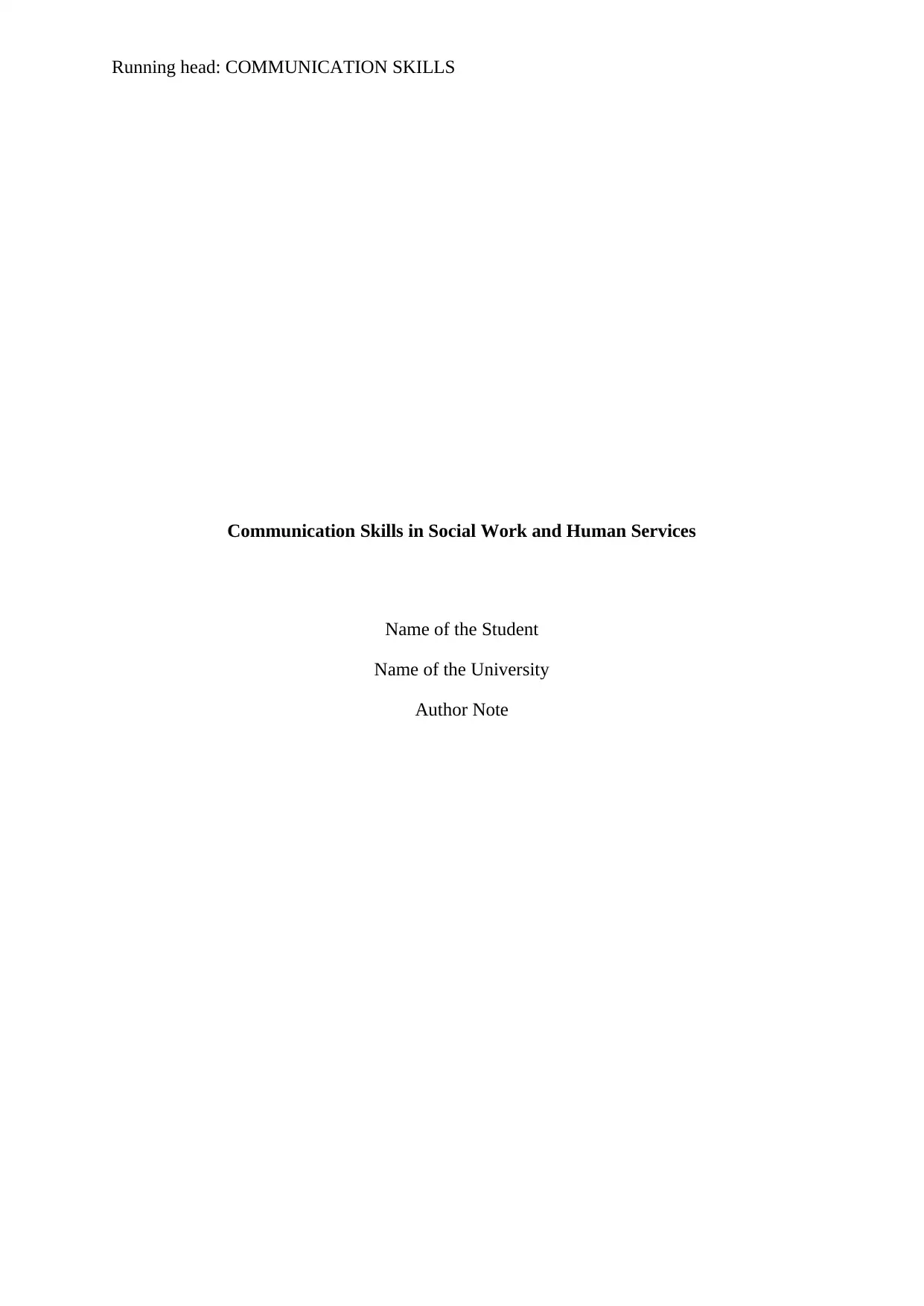
Running head: COMMUNICATION SKILLS
Communication Skills in Social Work and Human Services
Name of the Student
Name of the University
Author Note
Communication Skills in Social Work and Human Services
Name of the Student
Name of the University
Author Note
Paraphrase This Document
Need a fresh take? Get an instant paraphrase of this document with our AI Paraphraser

1COMMUNICATION SKILLS
Case Study #1: The Wates Family:
Cultural factors related to end of life considerations with Native Americans and how it
influences Todd and his family:
The cultural perceptions of death vary from culture to culture, each having its unique
way to understand death, which are also influenced by their religious beliefs. In the western
culture, time and death are considered as linear concepts, which have milestones which are to
be passed, as an individual is born, as they live and followed by death, which marks the final
milestone (Chapple et al., 2015). However, among several Native American cultures, the
perception of time is circular instead of linear. Such a perception implies that time has no
specific starting point, and death is only a point on this cycle of birth, life, death and rebirth.
Hence death is not considered the absolute end, but instead a passage to the next life or the
next world. Even though there exists an incredible diversity among Native American tribes in
terms of their beliefs, cultural practices, and lineages, a common perception exists about the
time being circular and death being only a point in this infinite journey the soul takes (Irish et
al., 2014). Beliefs of reincarnation is also common among several tribes, which considers
souls to be eternally present, and only moves from one body to another, after death, and never
leaving the world (Griffiths, 2018). Among other tribes, death is considered as the doorway
or passage to another world, where the soul moves on and joins the ancestors of the tribe who
died before them. Such perspectives lead to death being viewed as a more acceptable concept,
compared to the western culture, where death is a source of grief. In Native American
cultures, death is not really mourned, but instead celebrated, as the soul of their loved ones
becomes free of their earthly bodies, and move on to the next world (Grande, 20915). Todd,
who is nearing his end of life, is thinking about death, and how terminal patient death with
their own death. His family however did not wish to discuss this matter, showing that they are
not fully prepared to give up hope for Todd. This also shows that for Todd’s parents, the
Case Study #1: The Wates Family:
Cultural factors related to end of life considerations with Native Americans and how it
influences Todd and his family:
The cultural perceptions of death vary from culture to culture, each having its unique
way to understand death, which are also influenced by their religious beliefs. In the western
culture, time and death are considered as linear concepts, which have milestones which are to
be passed, as an individual is born, as they live and followed by death, which marks the final
milestone (Chapple et al., 2015). However, among several Native American cultures, the
perception of time is circular instead of linear. Such a perception implies that time has no
specific starting point, and death is only a point on this cycle of birth, life, death and rebirth.
Hence death is not considered the absolute end, but instead a passage to the next life or the
next world. Even though there exists an incredible diversity among Native American tribes in
terms of their beliefs, cultural practices, and lineages, a common perception exists about the
time being circular and death being only a point in this infinite journey the soul takes (Irish et
al., 2014). Beliefs of reincarnation is also common among several tribes, which considers
souls to be eternally present, and only moves from one body to another, after death, and never
leaving the world (Griffiths, 2018). Among other tribes, death is considered as the doorway
or passage to another world, where the soul moves on and joins the ancestors of the tribe who
died before them. Such perspectives lead to death being viewed as a more acceptable concept,
compared to the western culture, where death is a source of grief. In Native American
cultures, death is not really mourned, but instead celebrated, as the soul of their loved ones
becomes free of their earthly bodies, and move on to the next world (Grande, 20915). Todd,
who is nearing his end of life, is thinking about death, and how terminal patient death with
their own death. His family however did not wish to discuss this matter, showing that they are
not fully prepared to give up hope for Todd. This also shows that for Todd’s parents, the
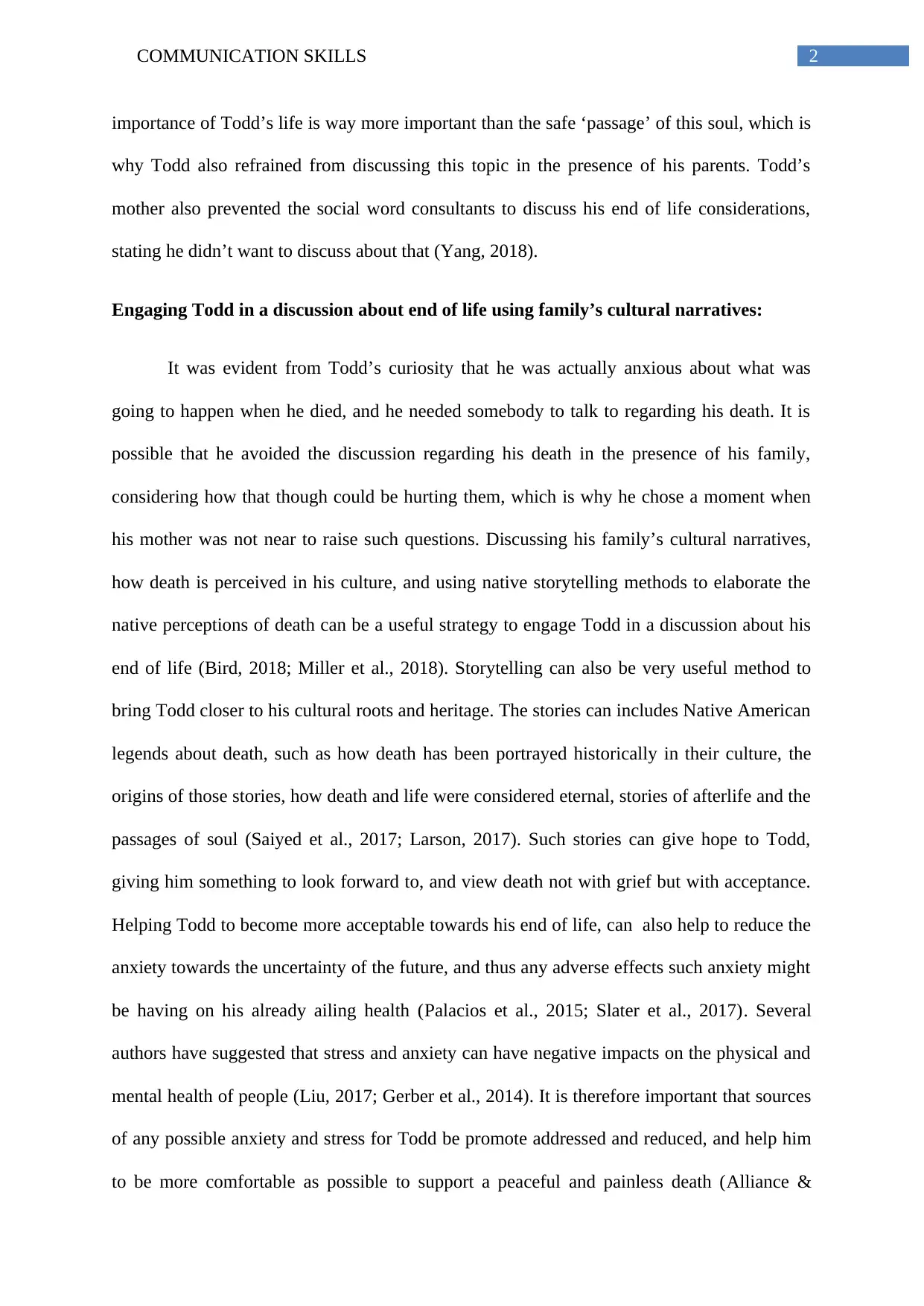
2COMMUNICATION SKILLS
importance of Todd’s life is way more important than the safe ‘passage’ of this soul, which is
why Todd also refrained from discussing this topic in the presence of his parents. Todd’s
mother also prevented the social word consultants to discuss his end of life considerations,
stating he didn’t want to discuss about that (Yang, 2018).
Engaging Todd in a discussion about end of life using family’s cultural narratives:
It was evident from Todd’s curiosity that he was actually anxious about what was
going to happen when he died, and he needed somebody to talk to regarding his death. It is
possible that he avoided the discussion regarding his death in the presence of his family,
considering how that though could be hurting them, which is why he chose a moment when
his mother was not near to raise such questions. Discussing his family’s cultural narratives,
how death is perceived in his culture, and using native storytelling methods to elaborate the
native perceptions of death can be a useful strategy to engage Todd in a discussion about his
end of life (Bird, 2018; Miller et al., 2018). Storytelling can also be very useful method to
bring Todd closer to his cultural roots and heritage. The stories can includes Native American
legends about death, such as how death has been portrayed historically in their culture, the
origins of those stories, how death and life were considered eternal, stories of afterlife and the
passages of soul (Saiyed et al., 2017; Larson, 2017). Such stories can give hope to Todd,
giving him something to look forward to, and view death not with grief but with acceptance.
Helping Todd to become more acceptable towards his end of life, can also help to reduce the
anxiety towards the uncertainty of the future, and thus any adverse effects such anxiety might
be having on his already ailing health (Palacios et al., 2015; Slater et al., 2017). Several
authors have suggested that stress and anxiety can have negative impacts on the physical and
mental health of people (Liu, 2017; Gerber et al., 2014). It is therefore important that sources
of any possible anxiety and stress for Todd be promote addressed and reduced, and help him
to be more comfortable as possible to support a peaceful and painless death (Alliance &
importance of Todd’s life is way more important than the safe ‘passage’ of this soul, which is
why Todd also refrained from discussing this topic in the presence of his parents. Todd’s
mother also prevented the social word consultants to discuss his end of life considerations,
stating he didn’t want to discuss about that (Yang, 2018).
Engaging Todd in a discussion about end of life using family’s cultural narratives:
It was evident from Todd’s curiosity that he was actually anxious about what was
going to happen when he died, and he needed somebody to talk to regarding his death. It is
possible that he avoided the discussion regarding his death in the presence of his family,
considering how that though could be hurting them, which is why he chose a moment when
his mother was not near to raise such questions. Discussing his family’s cultural narratives,
how death is perceived in his culture, and using native storytelling methods to elaborate the
native perceptions of death can be a useful strategy to engage Todd in a discussion about his
end of life (Bird, 2018; Miller et al., 2018). Storytelling can also be very useful method to
bring Todd closer to his cultural roots and heritage. The stories can includes Native American
legends about death, such as how death has been portrayed historically in their culture, the
origins of those stories, how death and life were considered eternal, stories of afterlife and the
passages of soul (Saiyed et al., 2017; Larson, 2017). Such stories can give hope to Todd,
giving him something to look forward to, and view death not with grief but with acceptance.
Helping Todd to become more acceptable towards his end of life, can also help to reduce the
anxiety towards the uncertainty of the future, and thus any adverse effects such anxiety might
be having on his already ailing health (Palacios et al., 2015; Slater et al., 2017). Several
authors have suggested that stress and anxiety can have negative impacts on the physical and
mental health of people (Liu, 2017; Gerber et al., 2014). It is therefore important that sources
of any possible anxiety and stress for Todd be promote addressed and reduced, and help him
to be more comfortable as possible to support a peaceful and painless death (Alliance &
⊘ This is a preview!⊘
Do you want full access?
Subscribe today to unlock all pages.

Trusted by 1+ million students worldwide
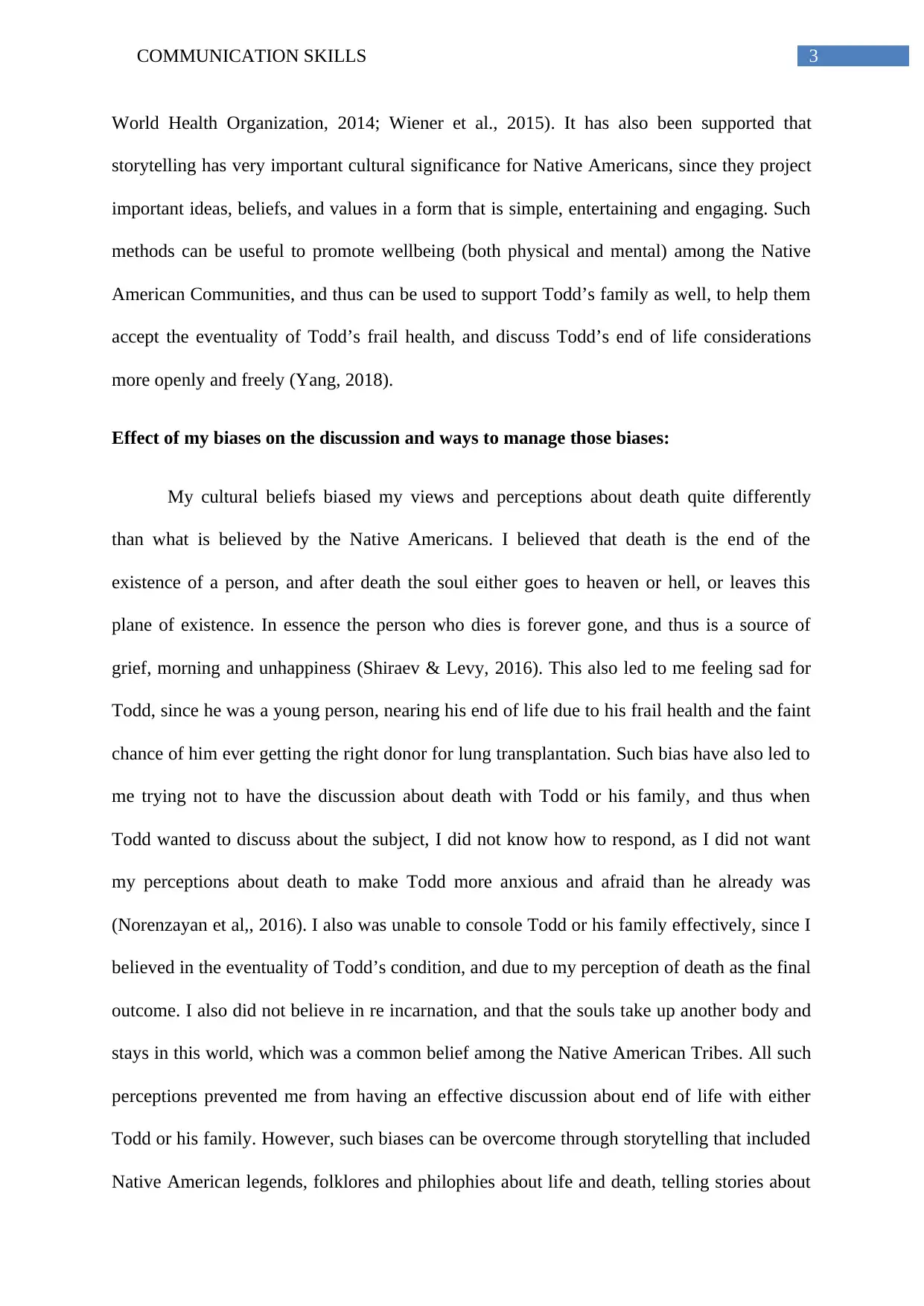
3COMMUNICATION SKILLS
World Health Organization, 2014; Wiener et al., 2015). It has also been supported that
storytelling has very important cultural significance for Native Americans, since they project
important ideas, beliefs, and values in a form that is simple, entertaining and engaging. Such
methods can be useful to promote wellbeing (both physical and mental) among the Native
American Communities, and thus can be used to support Todd’s family as well, to help them
accept the eventuality of Todd’s frail health, and discuss Todd’s end of life considerations
more openly and freely (Yang, 2018).
Effect of my biases on the discussion and ways to manage those biases:
My cultural beliefs biased my views and perceptions about death quite differently
than what is believed by the Native Americans. I believed that death is the end of the
existence of a person, and after death the soul either goes to heaven or hell, or leaves this
plane of existence. In essence the person who dies is forever gone, and thus is a source of
grief, morning and unhappiness (Shiraev & Levy, 2016). This also led to me feeling sad for
Todd, since he was a young person, nearing his end of life due to his frail health and the faint
chance of him ever getting the right donor for lung transplantation. Such bias have also led to
me trying not to have the discussion about death with Todd or his family, and thus when
Todd wanted to discuss about the subject, I did not know how to respond, as I did not want
my perceptions about death to make Todd more anxious and afraid than he already was
(Norenzayan et al,, 2016). I also was unable to console Todd or his family effectively, since I
believed in the eventuality of Todd’s condition, and due to my perception of death as the final
outcome. I also did not believe in re incarnation, and that the souls take up another body and
stays in this world, which was a common belief among the Native American Tribes. All such
perceptions prevented me from having an effective discussion about end of life with either
Todd or his family. However, such biases can be overcome through storytelling that included
Native American legends, folklores and philophies about life and death, telling stories about
World Health Organization, 2014; Wiener et al., 2015). It has also been supported that
storytelling has very important cultural significance for Native Americans, since they project
important ideas, beliefs, and values in a form that is simple, entertaining and engaging. Such
methods can be useful to promote wellbeing (both physical and mental) among the Native
American Communities, and thus can be used to support Todd’s family as well, to help them
accept the eventuality of Todd’s frail health, and discuss Todd’s end of life considerations
more openly and freely (Yang, 2018).
Effect of my biases on the discussion and ways to manage those biases:
My cultural beliefs biased my views and perceptions about death quite differently
than what is believed by the Native Americans. I believed that death is the end of the
existence of a person, and after death the soul either goes to heaven or hell, or leaves this
plane of existence. In essence the person who dies is forever gone, and thus is a source of
grief, morning and unhappiness (Shiraev & Levy, 2016). This also led to me feeling sad for
Todd, since he was a young person, nearing his end of life due to his frail health and the faint
chance of him ever getting the right donor for lung transplantation. Such bias have also led to
me trying not to have the discussion about death with Todd or his family, and thus when
Todd wanted to discuss about the subject, I did not know how to respond, as I did not want
my perceptions about death to make Todd more anxious and afraid than he already was
(Norenzayan et al,, 2016). I also was unable to console Todd or his family effectively, since I
believed in the eventuality of Todd’s condition, and due to my perception of death as the final
outcome. I also did not believe in re incarnation, and that the souls take up another body and
stays in this world, which was a common belief among the Native American Tribes. All such
perceptions prevented me from having an effective discussion about end of life with either
Todd or his family. However, such biases can be overcome through storytelling that included
Native American legends, folklores and philophies about life and death, telling stories about
Paraphrase This Document
Need a fresh take? Get an instant paraphrase of this document with our AI Paraphraser
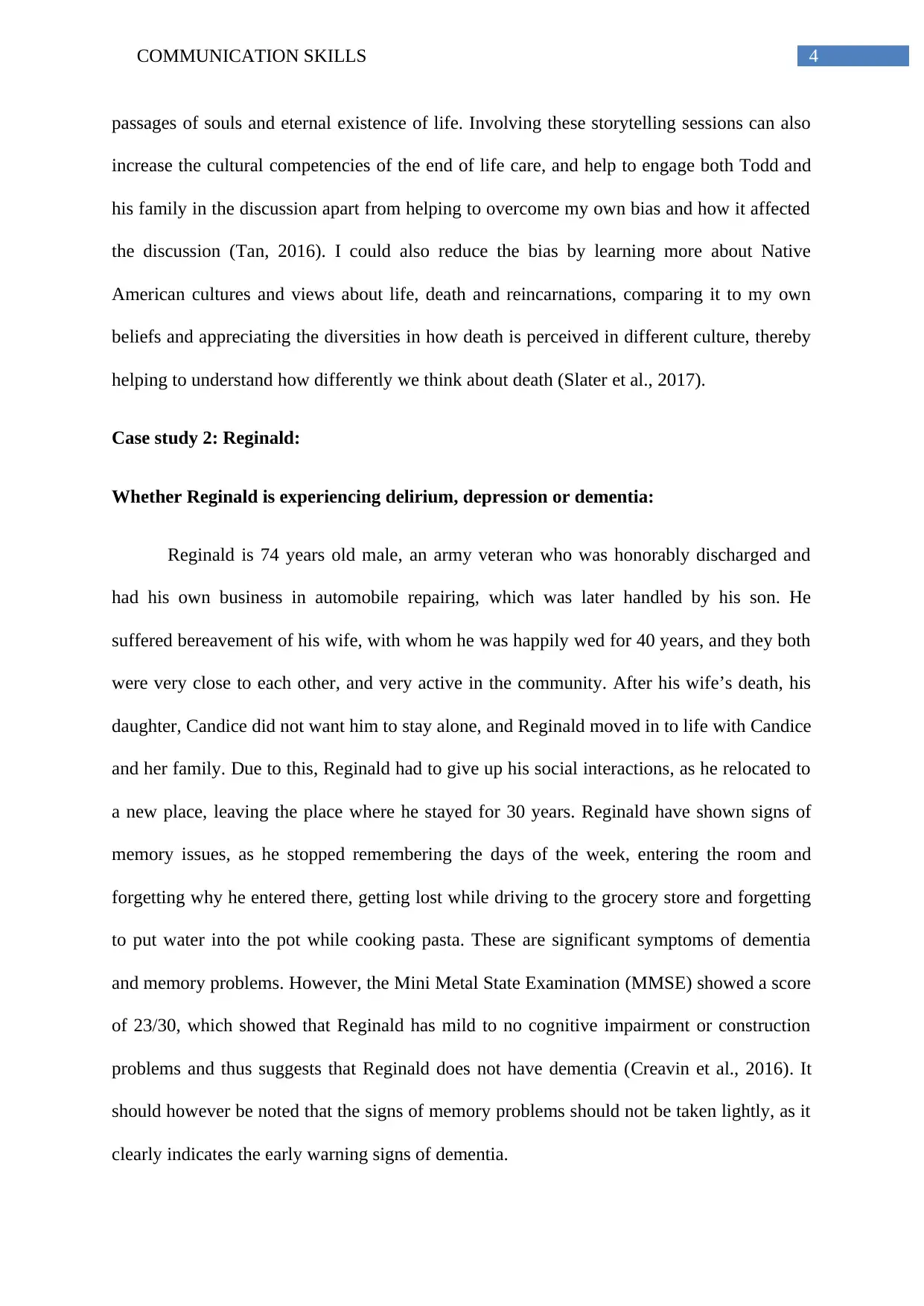
4COMMUNICATION SKILLS
passages of souls and eternal existence of life. Involving these storytelling sessions can also
increase the cultural competencies of the end of life care, and help to engage both Todd and
his family in the discussion apart from helping to overcome my own bias and how it affected
the discussion (Tan, 2016). I could also reduce the bias by learning more about Native
American cultures and views about life, death and reincarnations, comparing it to my own
beliefs and appreciating the diversities in how death is perceived in different culture, thereby
helping to understand how differently we think about death (Slater et al., 2017).
Case study 2: Reginald:
Whether Reginald is experiencing delirium, depression or dementia:
Reginald is 74 years old male, an army veteran who was honorably discharged and
had his own business in automobile repairing, which was later handled by his son. He
suffered bereavement of his wife, with whom he was happily wed for 40 years, and they both
were very close to each other, and very active in the community. After his wife’s death, his
daughter, Candice did not want him to stay alone, and Reginald moved in to life with Candice
and her family. Due to this, Reginald had to give up his social interactions, as he relocated to
a new place, leaving the place where he stayed for 30 years. Reginald have shown signs of
memory issues, as he stopped remembering the days of the week, entering the room and
forgetting why he entered there, getting lost while driving to the grocery store and forgetting
to put water into the pot while cooking pasta. These are significant symptoms of dementia
and memory problems. However, the Mini Metal State Examination (MMSE) showed a score
of 23/30, which showed that Reginald has mild to no cognitive impairment or construction
problems and thus suggests that Reginald does not have dementia (Creavin et al., 2016). It
should however be noted that the signs of memory problems should not be taken lightly, as it
clearly indicates the early warning signs of dementia.
passages of souls and eternal existence of life. Involving these storytelling sessions can also
increase the cultural competencies of the end of life care, and help to engage both Todd and
his family in the discussion apart from helping to overcome my own bias and how it affected
the discussion (Tan, 2016). I could also reduce the bias by learning more about Native
American cultures and views about life, death and reincarnations, comparing it to my own
beliefs and appreciating the diversities in how death is perceived in different culture, thereby
helping to understand how differently we think about death (Slater et al., 2017).
Case study 2: Reginald:
Whether Reginald is experiencing delirium, depression or dementia:
Reginald is 74 years old male, an army veteran who was honorably discharged and
had his own business in automobile repairing, which was later handled by his son. He
suffered bereavement of his wife, with whom he was happily wed for 40 years, and they both
were very close to each other, and very active in the community. After his wife’s death, his
daughter, Candice did not want him to stay alone, and Reginald moved in to life with Candice
and her family. Due to this, Reginald had to give up his social interactions, as he relocated to
a new place, leaving the place where he stayed for 30 years. Reginald have shown signs of
memory issues, as he stopped remembering the days of the week, entering the room and
forgetting why he entered there, getting lost while driving to the grocery store and forgetting
to put water into the pot while cooking pasta. These are significant symptoms of dementia
and memory problems. However, the Mini Metal State Examination (MMSE) showed a score
of 23/30, which showed that Reginald has mild to no cognitive impairment or construction
problems and thus suggests that Reginald does not have dementia (Creavin et al., 2016). It
should however be noted that the signs of memory problems should not be taken lightly, as it
clearly indicates the early warning signs of dementia.

5COMMUNICATION SKILLS
The Geriatric Depression Scale on the other hand showed a value of 8, which shows
that Reginald might be significantly depressed. Interview with Reginald also suggested that
he might be depressed, since he mentioned that he feels sad as he is not longer able to talk to
his wife anymore and did not get enough time with his children either. Moreover, moving to a
different city, he had to five up his social circle and friends, and spends most of time alone,
not doing anything. He felt that he was wasting his time by being idle all the day, which
might be adding to his depression. This can be supported by the views of several authors who
suggested that lack of physical activities, isolation from social circles or social life , being
alone, and episodes of bereavement can significantly increase the risks of depression, as well
as dementia at an old age (DiNapoli & Scogin, 2017; Pocklington et al., 2016).
Recommendations for treatment: (including local resources that can be used):
Considering that Reginald is showing the signs of depression as well as the early
warning signs of dementia, it is vital that both the conditions are addressed in his treatment
plan. It is important that Reginald be helped to cope up with the bereavement of his wife,
helping him to accept and move on with such an adverse life experience (She & Prigerson,
2018). He can also be supported to build his social circle, and be involved more in social
interactions and with the community, the way he used to be engaged in his previous
community. He can be recommended to increase his physical activities such as walking,
gardening, playing board games or visiting relatives, and avoid sitting at home idle (Morris &
Blocks, 2015).
Strategies to reduce depressive symptoms can include the involving of daily exercise
routines (such as walking, or gardening or oriental techniques such as yoga, tai chi or qi
gong), ensuring healthy diet and dishes that Reginald likes to eat, ensuring that Reginald gets
sufficient amounts of sleep, picking up new hobbies or activities or engagements and getting
The Geriatric Depression Scale on the other hand showed a value of 8, which shows
that Reginald might be significantly depressed. Interview with Reginald also suggested that
he might be depressed, since he mentioned that he feels sad as he is not longer able to talk to
his wife anymore and did not get enough time with his children either. Moreover, moving to a
different city, he had to five up his social circle and friends, and spends most of time alone,
not doing anything. He felt that he was wasting his time by being idle all the day, which
might be adding to his depression. This can be supported by the views of several authors who
suggested that lack of physical activities, isolation from social circles or social life , being
alone, and episodes of bereavement can significantly increase the risks of depression, as well
as dementia at an old age (DiNapoli & Scogin, 2017; Pocklington et al., 2016).
Recommendations for treatment: (including local resources that can be used):
Considering that Reginald is showing the signs of depression as well as the early
warning signs of dementia, it is vital that both the conditions are addressed in his treatment
plan. It is important that Reginald be helped to cope up with the bereavement of his wife,
helping him to accept and move on with such an adverse life experience (She & Prigerson,
2018). He can also be supported to build his social circle, and be involved more in social
interactions and with the community, the way he used to be engaged in his previous
community. He can be recommended to increase his physical activities such as walking,
gardening, playing board games or visiting relatives, and avoid sitting at home idle (Morris &
Blocks, 2015).
Strategies to reduce depressive symptoms can include the involving of daily exercise
routines (such as walking, or gardening or oriental techniques such as yoga, tai chi or qi
gong), ensuring healthy diet and dishes that Reginald likes to eat, ensuring that Reginald gets
sufficient amounts of sleep, picking up new hobbies or activities or engagements and getting
⊘ This is a preview!⊘
Do you want full access?
Subscribe today to unlock all pages.

Trusted by 1+ million students worldwide
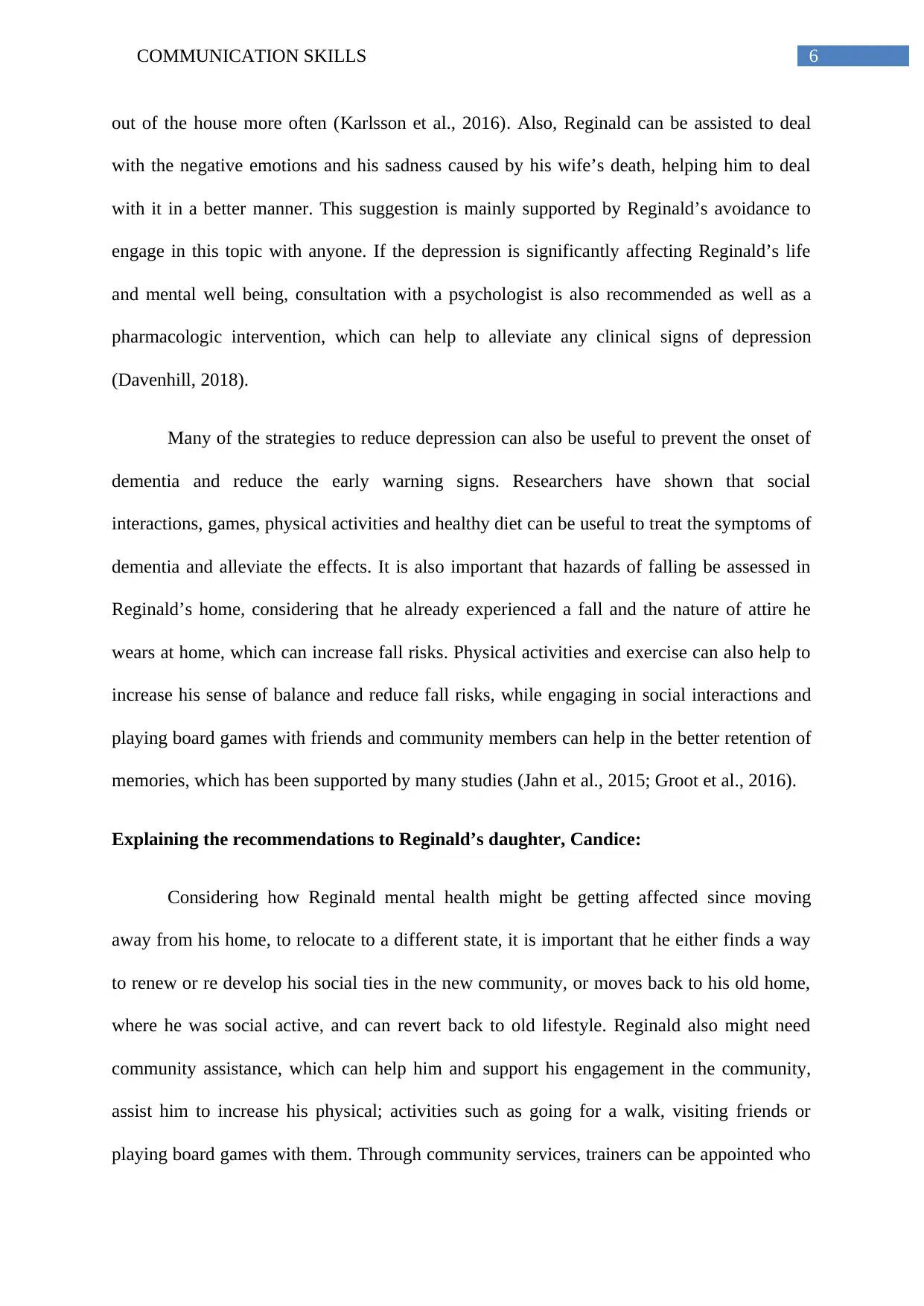
6COMMUNICATION SKILLS
out of the house more often (Karlsson et al., 2016). Also, Reginald can be assisted to deal
with the negative emotions and his sadness caused by his wife’s death, helping him to deal
with it in a better manner. This suggestion is mainly supported by Reginald’s avoidance to
engage in this topic with anyone. If the depression is significantly affecting Reginald’s life
and mental well being, consultation with a psychologist is also recommended as well as a
pharmacologic intervention, which can help to alleviate any clinical signs of depression
(Davenhill, 2018).
Many of the strategies to reduce depression can also be useful to prevent the onset of
dementia and reduce the early warning signs. Researchers have shown that social
interactions, games, physical activities and healthy diet can be useful to treat the symptoms of
dementia and alleviate the effects. It is also important that hazards of falling be assessed in
Reginald’s home, considering that he already experienced a fall and the nature of attire he
wears at home, which can increase fall risks. Physical activities and exercise can also help to
increase his sense of balance and reduce fall risks, while engaging in social interactions and
playing board games with friends and community members can help in the better retention of
memories, which has been supported by many studies (Jahn et al., 2015; Groot et al., 2016).
Explaining the recommendations to Reginald’s daughter, Candice:
Considering how Reginald mental health might be getting affected since moving
away from his home, to relocate to a different state, it is important that he either finds a way
to renew or re develop his social ties in the new community, or moves back to his old home,
where he was social active, and can revert back to old lifestyle. Reginald also might need
community assistance, which can help him and support his engagement in the community,
assist him to increase his physical; activities such as going for a walk, visiting friends or
playing board games with them. Through community services, trainers can be appointed who
out of the house more often (Karlsson et al., 2016). Also, Reginald can be assisted to deal
with the negative emotions and his sadness caused by his wife’s death, helping him to deal
with it in a better manner. This suggestion is mainly supported by Reginald’s avoidance to
engage in this topic with anyone. If the depression is significantly affecting Reginald’s life
and mental well being, consultation with a psychologist is also recommended as well as a
pharmacologic intervention, which can help to alleviate any clinical signs of depression
(Davenhill, 2018).
Many of the strategies to reduce depression can also be useful to prevent the onset of
dementia and reduce the early warning signs. Researchers have shown that social
interactions, games, physical activities and healthy diet can be useful to treat the symptoms of
dementia and alleviate the effects. It is also important that hazards of falling be assessed in
Reginald’s home, considering that he already experienced a fall and the nature of attire he
wears at home, which can increase fall risks. Physical activities and exercise can also help to
increase his sense of balance and reduce fall risks, while engaging in social interactions and
playing board games with friends and community members can help in the better retention of
memories, which has been supported by many studies (Jahn et al., 2015; Groot et al., 2016).
Explaining the recommendations to Reginald’s daughter, Candice:
Considering how Reginald mental health might be getting affected since moving
away from his home, to relocate to a different state, it is important that he either finds a way
to renew or re develop his social ties in the new community, or moves back to his old home,
where he was social active, and can revert back to old lifestyle. Reginald also might need
community assistance, which can help him and support his engagement in the community,
assist him to increase his physical; activities such as going for a walk, visiting friends or
playing board games with them. Through community services, trainers can be appointed who
Paraphrase This Document
Need a fresh take? Get an instant paraphrase of this document with our AI Paraphraser

7COMMUNICATION SKILLS
can provide classes on yoga, tai chi or qu gong, all of which can help to improve balance,
cardiovascular functions and also improve the mental well being (Bunn et al., 2016). Healthy
diet recommendations can also be used to help Reginald select healthier diet options and
avoid unhealthy ones. It is also important to highlight the fact that moving away from his
community and not being able to socialize with his friends have also affected Reginald’s
depression, as he feels that he is wasting his time away, and feeling miserable about it.
Reginald understands though that his daughter is worried about him, and for good reasons,
but being at the position where he is not really helping Reginald’s health, and might be even
adversely affecting him. Relocating back might therefore be the best option for him, and f
such is not possible or feasible, the nest best thing would be to help Reginald to build his
social ties anew, and also helping him to engage his time in a more meaningful manner, that
would keep him mentally and physically engaged (Kilmova & Kuca, 2018). Also,
environmental hazards of falling at home should be assessed and minimized, and necessary
modifications be made to his home, to reduce the risks of falling and thus prevent any
avoidable injuries (Booth et al., 2015).
can provide classes on yoga, tai chi or qu gong, all of which can help to improve balance,
cardiovascular functions and also improve the mental well being (Bunn et al., 2016). Healthy
diet recommendations can also be used to help Reginald select healthier diet options and
avoid unhealthy ones. It is also important to highlight the fact that moving away from his
community and not being able to socialize with his friends have also affected Reginald’s
depression, as he feels that he is wasting his time away, and feeling miserable about it.
Reginald understands though that his daughter is worried about him, and for good reasons,
but being at the position where he is not really helping Reginald’s health, and might be even
adversely affecting him. Relocating back might therefore be the best option for him, and f
such is not possible or feasible, the nest best thing would be to help Reginald to build his
social ties anew, and also helping him to engage his time in a more meaningful manner, that
would keep him mentally and physically engaged (Kilmova & Kuca, 2018). Also,
environmental hazards of falling at home should be assessed and minimized, and necessary
modifications be made to his home, to reduce the risks of falling and thus prevent any
avoidable injuries (Booth et al., 2015).
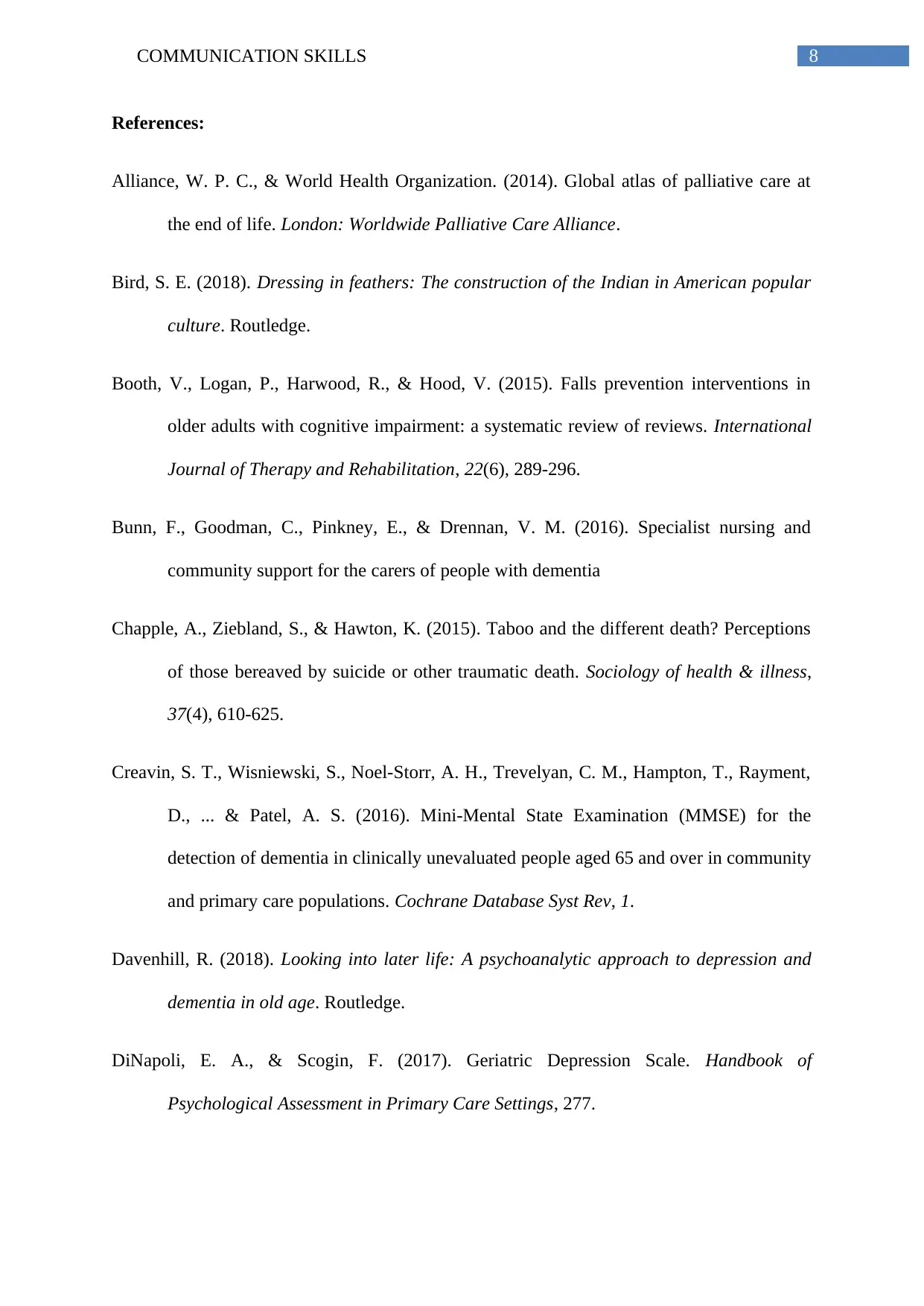
8COMMUNICATION SKILLS
References:
Alliance, W. P. C., & World Health Organization. (2014). Global atlas of palliative care at
the end of life. London: Worldwide Palliative Care Alliance.
Bird, S. E. (2018). Dressing in feathers: The construction of the Indian in American popular
culture. Routledge.
Booth, V., Logan, P., Harwood, R., & Hood, V. (2015). Falls prevention interventions in
older adults with cognitive impairment: a systematic review of reviews. International
Journal of Therapy and Rehabilitation, 22(6), 289-296.
Bunn, F., Goodman, C., Pinkney, E., & Drennan, V. M. (2016). Specialist nursing and
community support for the carers of people with dementia
Chapple, A., Ziebland, S., & Hawton, K. (2015). Taboo and the different death? Perceptions
of those bereaved by suicide or other traumatic death. Sociology of health & illness,
37(4), 610-625.
Creavin, S. T., Wisniewski, S., Noel-Storr, A. H., Trevelyan, C. M., Hampton, T., Rayment,
D., ... & Patel, A. S. (2016). Mini-Mental State Examination (MMSE) for the
detection of dementia in clinically unevaluated people aged 65 and over in community
and primary care populations. Cochrane Database Syst Rev, 1.
Davenhill, R. (2018). Looking into later life: A psychoanalytic approach to depression and
dementia in old age. Routledge.
DiNapoli, E. A., & Scogin, F. (2017). Geriatric Depression Scale. Handbook of
Psychological Assessment in Primary Care Settings, 277.
References:
Alliance, W. P. C., & World Health Organization. (2014). Global atlas of palliative care at
the end of life. London: Worldwide Palliative Care Alliance.
Bird, S. E. (2018). Dressing in feathers: The construction of the Indian in American popular
culture. Routledge.
Booth, V., Logan, P., Harwood, R., & Hood, V. (2015). Falls prevention interventions in
older adults with cognitive impairment: a systematic review of reviews. International
Journal of Therapy and Rehabilitation, 22(6), 289-296.
Bunn, F., Goodman, C., Pinkney, E., & Drennan, V. M. (2016). Specialist nursing and
community support for the carers of people with dementia
Chapple, A., Ziebland, S., & Hawton, K. (2015). Taboo and the different death? Perceptions
of those bereaved by suicide or other traumatic death. Sociology of health & illness,
37(4), 610-625.
Creavin, S. T., Wisniewski, S., Noel-Storr, A. H., Trevelyan, C. M., Hampton, T., Rayment,
D., ... & Patel, A. S. (2016). Mini-Mental State Examination (MMSE) for the
detection of dementia in clinically unevaluated people aged 65 and over in community
and primary care populations. Cochrane Database Syst Rev, 1.
Davenhill, R. (2018). Looking into later life: A psychoanalytic approach to depression and
dementia in old age. Routledge.
DiNapoli, E. A., & Scogin, F. (2017). Geriatric Depression Scale. Handbook of
Psychological Assessment in Primary Care Settings, 277.
⊘ This is a preview!⊘
Do you want full access?
Subscribe today to unlock all pages.

Trusted by 1+ million students worldwide

9COMMUNICATION SKILLS
Gerber, M., Jonsdottir, I. H., Lindwall, M., & Ahlborg Jr, G. (2014). Physical activity in
employees with differing occupational stress and mental health profiles: A latent
profile analysis. Psychology of Sport and Exercise, 15(6), 649-658.
Grande, S. (2015). Red pedagogy: Native American social and political thought. Rowman &
Littlefield.
Griffiths, A. (2018). Science and spectacle: Native American representation in early cinema.
In Dressing in Feathers (pp. 79-95). Routledge.
Groot, C., Hooghiemstra, A. M., Raijmakers, P. G. H. M., Van Berckel, B. N. M., Scheltens,
P., Scherder, E. J. A., ... & Ossenkoppele, R. (2016). The effect of physical activity on
cognitive function in patients with dementia: a meta-analysis of randomized control
trials. Ageing research reviews, 25, 13-23.
Irish, D. P., Lundquist, K. F., & Nelsen, V. J. (2014). Ethnic variations in dying, death and
grief: Diversity in universality. Taylor & Francis.
Jahn, K., Kressig, R. W., Bridenbaugh, S. A., Brandt, T., & Schniepp, R. (2015). Dizziness
and unstable gait in old age: Etiology, diagnosis and treatment. Deutsches Ärzteblatt
International, 112(23), 387.
Karlsson, B., Johnell, K., Sigström, R., Sjöberg, L., & Fratiglioni, L. (2016). Depression and
depression treatment in a population-based study of individuals over 60 years old
without dementia. The American Journal of Geriatric Psychiatry, 24(8), 615-623.
Klimova, B., & Kuca, K. (2018). Multinutrient Intervention in the Prevention and Treatment
of Dementia. In Role of the Mediterranean Diet in the Brain and Neurodegenerative
Diseases (pp. 341-351).
Gerber, M., Jonsdottir, I. H., Lindwall, M., & Ahlborg Jr, G. (2014). Physical activity in
employees with differing occupational stress and mental health profiles: A latent
profile analysis. Psychology of Sport and Exercise, 15(6), 649-658.
Grande, S. (2015). Red pedagogy: Native American social and political thought. Rowman &
Littlefield.
Griffiths, A. (2018). Science and spectacle: Native American representation in early cinema.
In Dressing in Feathers (pp. 79-95). Routledge.
Groot, C., Hooghiemstra, A. M., Raijmakers, P. G. H. M., Van Berckel, B. N. M., Scheltens,
P., Scherder, E. J. A., ... & Ossenkoppele, R. (2016). The effect of physical activity on
cognitive function in patients with dementia: a meta-analysis of randomized control
trials. Ageing research reviews, 25, 13-23.
Irish, D. P., Lundquist, K. F., & Nelsen, V. J. (2014). Ethnic variations in dying, death and
grief: Diversity in universality. Taylor & Francis.
Jahn, K., Kressig, R. W., Bridenbaugh, S. A., Brandt, T., & Schniepp, R. (2015). Dizziness
and unstable gait in old age: Etiology, diagnosis and treatment. Deutsches Ärzteblatt
International, 112(23), 387.
Karlsson, B., Johnell, K., Sigström, R., Sjöberg, L., & Fratiglioni, L. (2016). Depression and
depression treatment in a population-based study of individuals over 60 years old
without dementia. The American Journal of Geriatric Psychiatry, 24(8), 615-623.
Klimova, B., & Kuca, K. (2018). Multinutrient Intervention in the Prevention and Treatment
of Dementia. In Role of the Mediterranean Diet in the Brain and Neurodegenerative
Diseases (pp. 341-351).
Paraphrase This Document
Need a fresh take? Get an instant paraphrase of this document with our AI Paraphraser
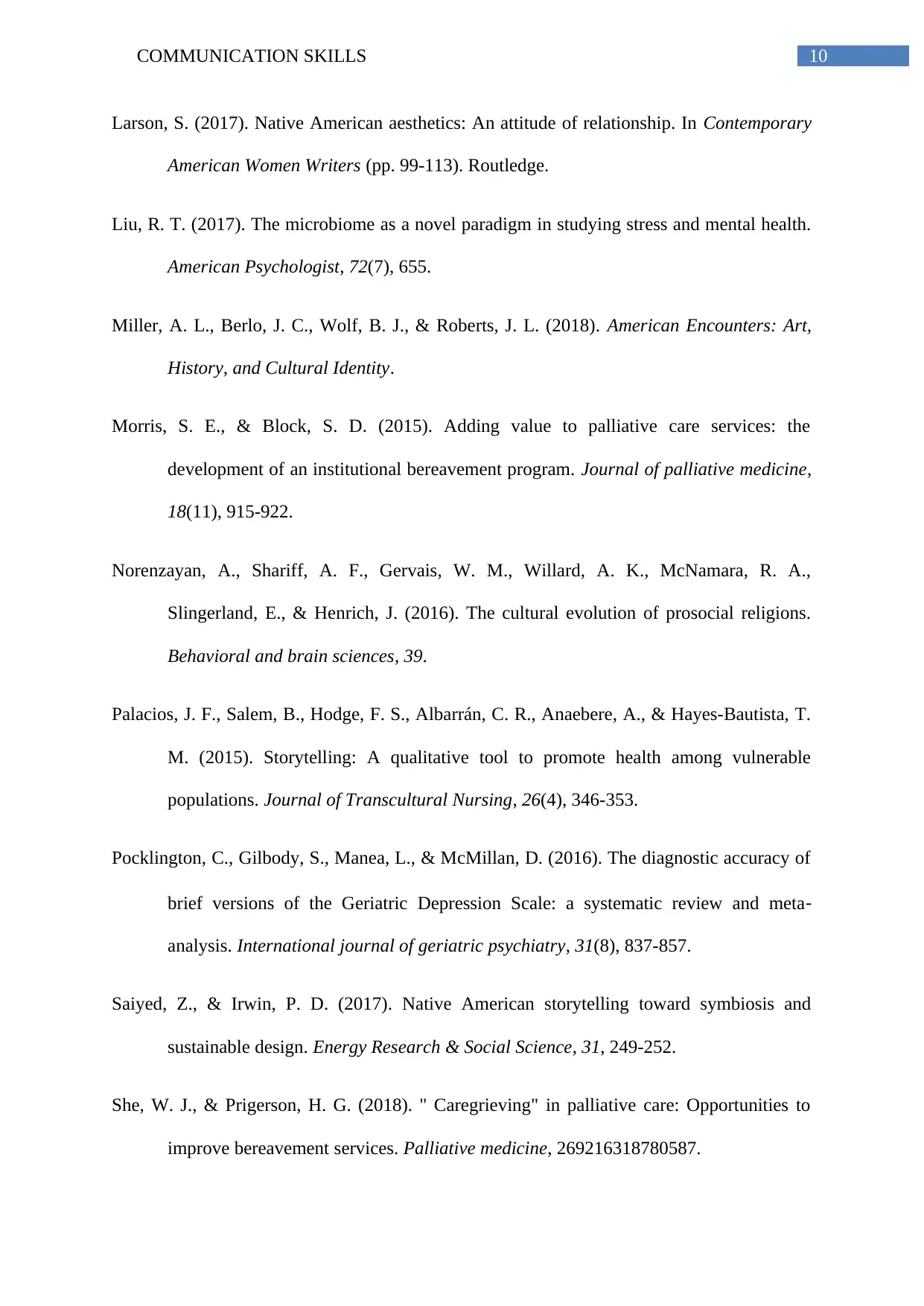
10COMMUNICATION SKILLS
Larson, S. (2017). Native American aesthetics: An attitude of relationship. In Contemporary
American Women Writers (pp. 99-113). Routledge.
Liu, R. T. (2017). The microbiome as a novel paradigm in studying stress and mental health.
American Psychologist, 72(7), 655.
Miller, A. L., Berlo, J. C., Wolf, B. J., & Roberts, J. L. (2018). American Encounters: Art,
History, and Cultural Identity.
Morris, S. E., & Block, S. D. (2015). Adding value to palliative care services: the
development of an institutional bereavement program. Journal of palliative medicine,
18(11), 915-922.
Norenzayan, A., Shariff, A. F., Gervais, W. M., Willard, A. K., McNamara, R. A.,
Slingerland, E., & Henrich, J. (2016). The cultural evolution of prosocial religions.
Behavioral and brain sciences, 39.
Palacios, J. F., Salem, B., Hodge, F. S., Albarrán, C. R., Anaebere, A., & Hayes-Bautista, T.
M. (2015). Storytelling: A qualitative tool to promote health among vulnerable
populations. Journal of Transcultural Nursing, 26(4), 346-353.
Pocklington, C., Gilbody, S., Manea, L., & McMillan, D. (2016). The diagnostic accuracy of
brief versions of the Geriatric Depression Scale: a systematic review and meta‐
analysis. International journal of geriatric psychiatry, 31(8), 837-857.
Saiyed, Z., & Irwin, P. D. (2017). Native American storytelling toward symbiosis and
sustainable design. Energy Research & Social Science, 31, 249-252.
She, W. J., & Prigerson, H. G. (2018). " Caregrieving" in palliative care: Opportunities to
improve bereavement services. Palliative medicine, 269216318780587.
Larson, S. (2017). Native American aesthetics: An attitude of relationship. In Contemporary
American Women Writers (pp. 99-113). Routledge.
Liu, R. T. (2017). The microbiome as a novel paradigm in studying stress and mental health.
American Psychologist, 72(7), 655.
Miller, A. L., Berlo, J. C., Wolf, B. J., & Roberts, J. L. (2018). American Encounters: Art,
History, and Cultural Identity.
Morris, S. E., & Block, S. D. (2015). Adding value to palliative care services: the
development of an institutional bereavement program. Journal of palliative medicine,
18(11), 915-922.
Norenzayan, A., Shariff, A. F., Gervais, W. M., Willard, A. K., McNamara, R. A.,
Slingerland, E., & Henrich, J. (2016). The cultural evolution of prosocial religions.
Behavioral and brain sciences, 39.
Palacios, J. F., Salem, B., Hodge, F. S., Albarrán, C. R., Anaebere, A., & Hayes-Bautista, T.
M. (2015). Storytelling: A qualitative tool to promote health among vulnerable
populations. Journal of Transcultural Nursing, 26(4), 346-353.
Pocklington, C., Gilbody, S., Manea, L., & McMillan, D. (2016). The diagnostic accuracy of
brief versions of the Geriatric Depression Scale: a systematic review and meta‐
analysis. International journal of geriatric psychiatry, 31(8), 837-857.
Saiyed, Z., & Irwin, P. D. (2017). Native American storytelling toward symbiosis and
sustainable design. Energy Research & Social Science, 31, 249-252.
She, W. J., & Prigerson, H. G. (2018). " Caregrieving" in palliative care: Opportunities to
improve bereavement services. Palliative medicine, 269216318780587.
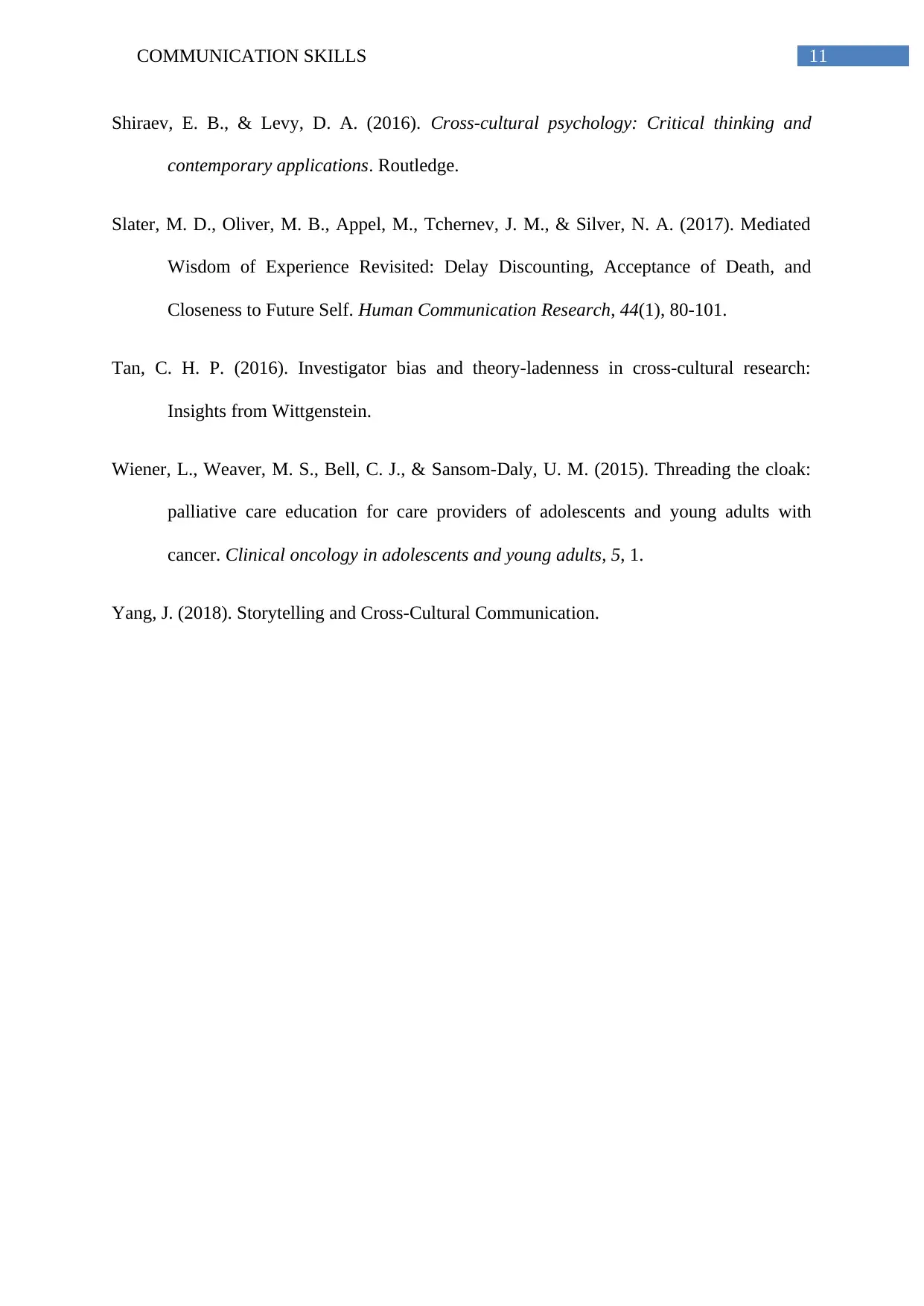
11COMMUNICATION SKILLS
Shiraev, E. B., & Levy, D. A. (2016). Cross-cultural psychology: Critical thinking and
contemporary applications. Routledge.
Slater, M. D., Oliver, M. B., Appel, M., Tchernev, J. M., & Silver, N. A. (2017). Mediated
Wisdom of Experience Revisited: Delay Discounting, Acceptance of Death, and
Closeness to Future Self. Human Communication Research, 44(1), 80-101.
Tan, C. H. P. (2016). Investigator bias and theory-ladenness in cross-cultural research:
Insights from Wittgenstein.
Wiener, L., Weaver, M. S., Bell, C. J., & Sansom-Daly, U. M. (2015). Threading the cloak:
palliative care education for care providers of adolescents and young adults with
cancer. Clinical oncology in adolescents and young adults, 5, 1.
Yang, J. (2018). Storytelling and Cross-Cultural Communication.
Shiraev, E. B., & Levy, D. A. (2016). Cross-cultural psychology: Critical thinking and
contemporary applications. Routledge.
Slater, M. D., Oliver, M. B., Appel, M., Tchernev, J. M., & Silver, N. A. (2017). Mediated
Wisdom of Experience Revisited: Delay Discounting, Acceptance of Death, and
Closeness to Future Self. Human Communication Research, 44(1), 80-101.
Tan, C. H. P. (2016). Investigator bias and theory-ladenness in cross-cultural research:
Insights from Wittgenstein.
Wiener, L., Weaver, M. S., Bell, C. J., & Sansom-Daly, U. M. (2015). Threading the cloak:
palliative care education for care providers of adolescents and young adults with
cancer. Clinical oncology in adolescents and young adults, 5, 1.
Yang, J. (2018). Storytelling and Cross-Cultural Communication.
⊘ This is a preview!⊘
Do you want full access?
Subscribe today to unlock all pages.

Trusted by 1+ million students worldwide
1 out of 13
Your All-in-One AI-Powered Toolkit for Academic Success.
+13062052269
info@desklib.com
Available 24*7 on WhatsApp / Email
![[object Object]](/_next/static/media/star-bottom.7253800d.svg)
Unlock your academic potential
Copyright © 2020–2025 A2Z Services. All Rights Reserved. Developed and managed by ZUCOL.
